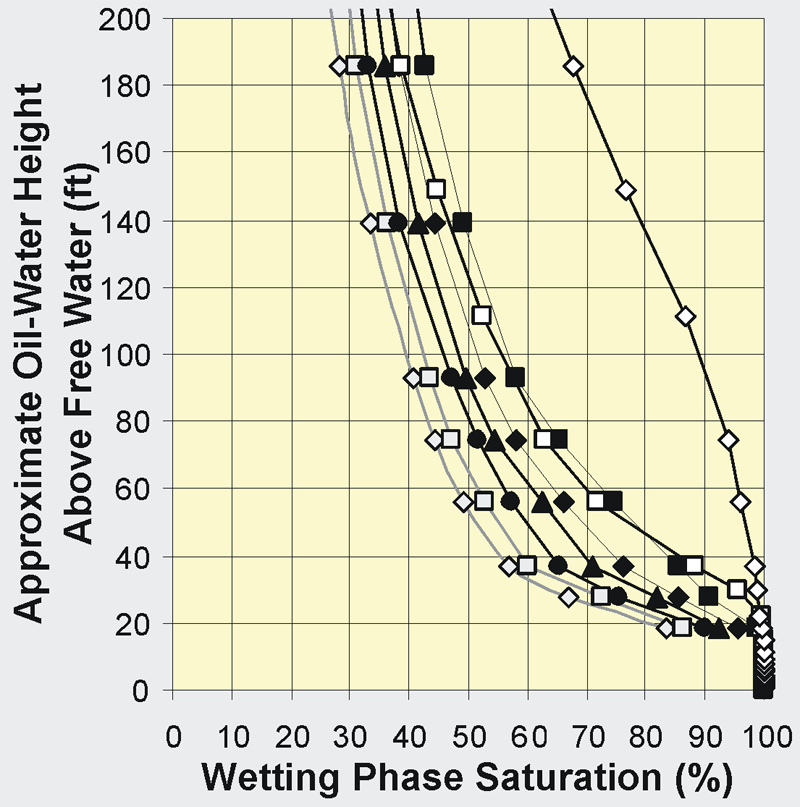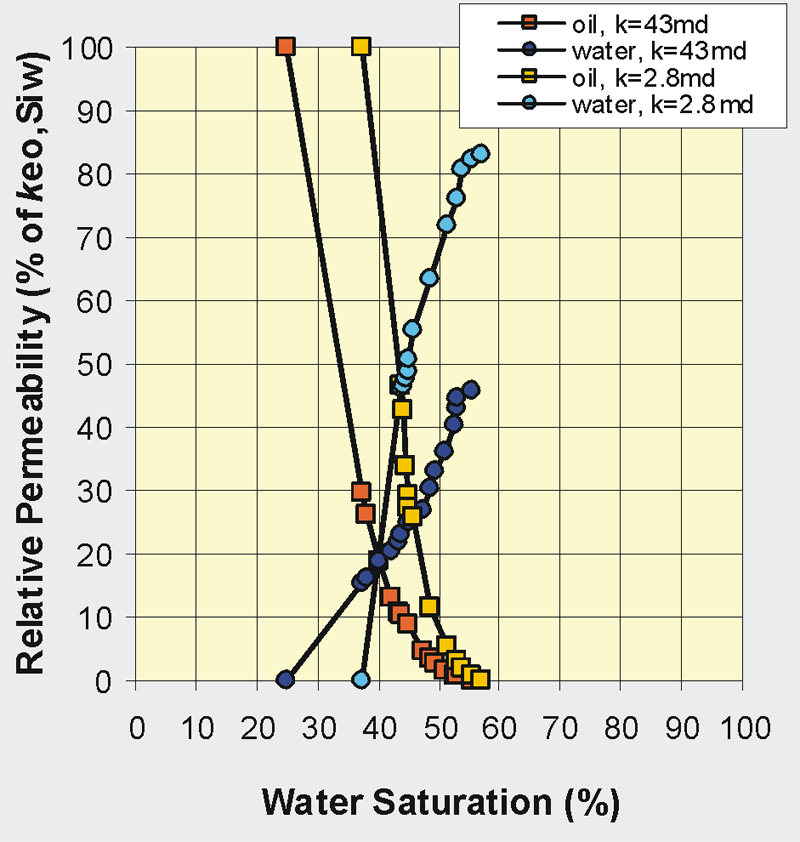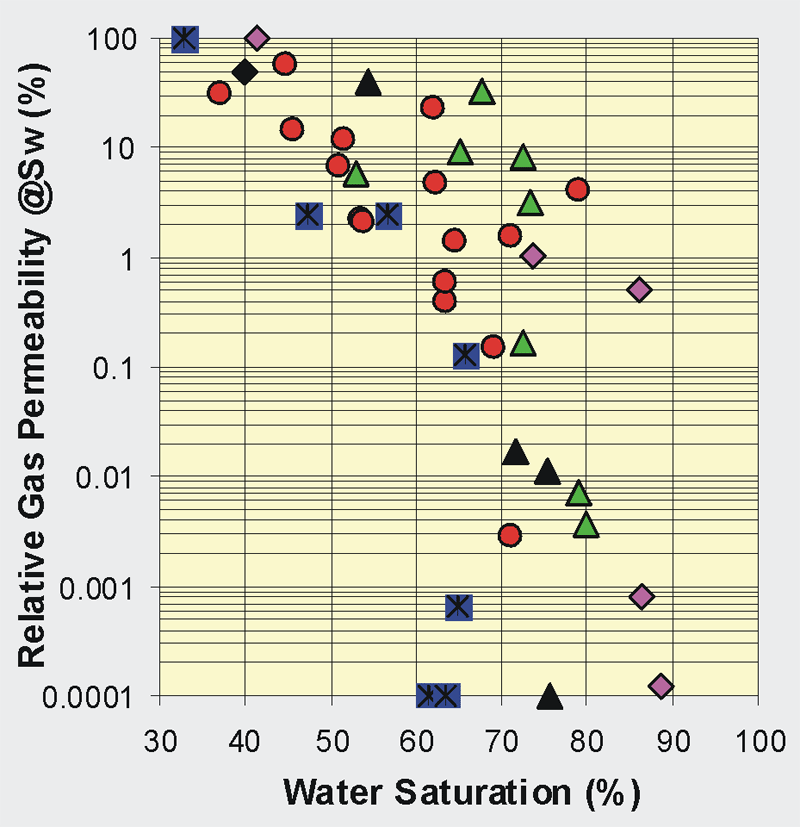
Characterization of Mississippian Osage Chat in South-Central
Kansas
Kansas Geological Survey
Open-file Report 2002-50

|
|
Kansas Geological Survey Open-file Report 2002-50 |

Irreducible water, bound in the chert microporosity, greatly diminishes the resistivity log response and leads to high water saturations in zones that produce large amounts of oil with little water. High bound water saturations in the Chat have led to difficulty in estimating reserves and determining producible zones. This problem in water saturations is further complicated by difficulty in establishing free water level. While some fields exhibit apparent structural closure greater than 200 feet, the presence of nearly isolated blocks of production within these fields surrounded by nonproductive areas may indicate that there is not a continuous hydrocarbon column and that free water level is independently established for each block.
Capillary pressure curves reported by Duren (1960, 1967; Figure) for autoclastic chert samples from Glick Field illustrate a classic trend of decreasing “irreducible” wetting phase saturation (Siw) with increasing permeability. The relatively high Siw values, between 20 and 30% at 1,200 psi air-mercury capillary pressure, are consistent with the presence of microporosity. No abrupt change in slope is evident in the curves indicating that there are not two distinctly different pore systems. The high Sw values for given hydrocarbon column heights explain high water saturations calculated from resistivity logs in the Chat.


Relative Permeability
Figure shows the unsteady-state imbibition water-oil relative
permeability relations for two autoclastic chert samples from
the Gulf 4-4 School Trust in Hardtner Field. These cores exhibit
initial water saturation values, obtained by dynamic flooding
displacement of water with refined oil, consistent with Siw values
from the capillary pressure curves. Both curves exhibit an abrupt
increase in water relative permeability (krw) and decrease in
oil relative permeability (kro) with increasing water saturation
and high krw at residual oil saturation. These characteristics
are often associated with intermediate wettability. However, high
Siw values are consistent with water wetness. The curves are best
explained by assuming a dual water-wet pore system.
As noted above, autoclastic chert can develop higher permeability channels along enhanced porosity microfractures. This system of pores could have oil displaced leaving high oil saturations in the smaller pores within the clasts. This oil would not be trapped but would exhibit significantly lower effective permeability than the enhanced pore system and would therefore be unswept in standard testing. It could be anticipated that if permeability is dominated by a uniform enhanced fracture pore system, then the relative portion of total porosity of this pore system would increase with increasing total permeability. This would result in a greater amount of oil displacement with increasing permeability as shown by the two samples.
Further relative permeability work is needed in these chert reservoirs to better understand lithofacies controls on relative permeability curve shapes. Similar questions in interpretation of relative permeability could be anticipated for other “dual” porosity chert reservoirs.
To better understand keg,Sw and krg,Sw, core plugs of various lithofacies from the Spivey-Grabs Field were saturated with brine and desaturated using the porous-plate capillary pressure method at an air-brine capillary pressure of 33 psia (230 kPa), corresponding to approximately 55 feet (16.8 m) above free water level. While at partial water saturation, the effective permeability to gas was measured with the brine phase held stationary. Figure shows that for cores exhibiting saturations of less than 50%, relative gas permeability (krg) is greater than 10%. The chert conglomerate sample exhibiting krg=100% contained little clay infill and had insignificant blockage of the flow path by clay. In contrast, the other chert conglomerate samples exhibit varying degrees of clay-filled fractures obstructing the flow path.
Relative permeabilities decrease rapidly within increasing water saturation greater than 60%. At saturations characteristic of 55 feet above free water level, nodular to bedded cherts generally exhibit krg values less than 10%. Nearly all dolomite mudstone and bioclastic wacke/grainstones exhibit krg values less than 1%. Except for two samples exhibiting mixed lithofacies. Given the low absolute permeabilities of the mudstones and bioclastic wacke/grainstones and the further decrease in effective hydrocarbon permeability at water saturations representative of many fields, it is likely that these lithofacies do not represent a source of significant oil production.
|
|